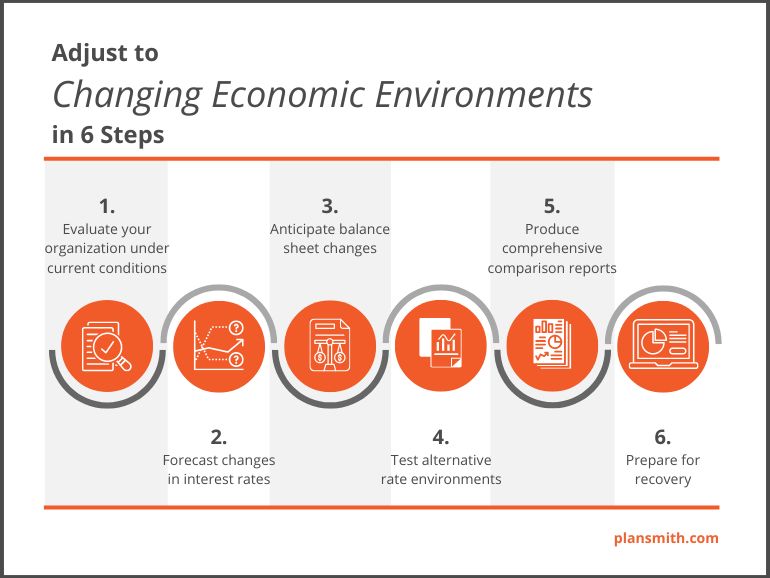3 minutes
Use this simple six-step checklist for continuous planning in all economic environments.
Sponsored by Plansmith
Uncertainty and volatility seem to be the only consistent elements in the post-COVID economy. So, how do you adequately measure the financial impact today’s economic landscape will have on your business? By utilizing a true planning model.
A professional forecasting platform for budgeting and asset/liability management and interest rate risk adapts to changing conditions. As such a system is relationship-driven, it can be set to react to environmental changes, including rates. As the rate environment shifts, so should your balance sheet growth and product mix. Planning models help you test the impact of such changes and measure results in minutes, not hours.
Though market conditions may be changing, the response we recommend for fluctuating environments does not. Below is a simple six-step checklist for continuous planning in all economic environments.
1. Evaluate Your Organization Under Current Conditions
- Make sure your historical data is current.
- Revise the rate forecast if necessary to reflect today’s rate conditions.
- Produce reports comparing the full projected year to this year’s budget. Rather than a traditional variance report, a for-the-year comparison will give you a better understanding of where you are headed versus where you had hoped to be.
2. Forecast Changes in Interest Rates
- Enter expected rate changes for the remainder of the current year.
- At a minimum, create two alternative scenarios: one for rising rates and one for falling rates. If using a Plansmith model, these steps are included within our professional rate download.
3. Anticipate Balance Sheet Changes
- Adjust the product mix within loans to anticipate changes created by customer demand and the desired balance between fixed and variable rate products.
- For deposits, revise pricing as needed to retain, redirect or even reduce customer growth.
4. Test Alternative Rate Environments
- Calculate and compare rising and falling rate scenarios against your most likely plan scenario. If using Plansmith’s model, these are pre-built and can be calculated simultaneously in seconds.
- Test dramatic rate change conditions by running a full rate shock simulation of net interest margin and economic value of equity. These, too, are automated within Plansmith’s model and produce a comprehensive risk report for your asset/liability committee, board, and examiners.
5. Produce Comprehensive Comparison Reports
- Create a report package that captures your scenario results side by side. Plansmith’s scenario comparison report is often used here, along with our rate/volume/mix variance analysis report, which documents changes in the plan as compared to your original budget. This report is based on allocations of variances due to rate, balance change or a factor involving both.
6. Prepare for Recovery
Based on the information provided, select the plan environment you believe is most likely and prepare an action plan for execution. Use a playbook, such as Plansmith’s cloud-based Budget Playbook, to document objectives and actionable tasks identified as essential for plan execution.

These six factors can sound overwhelming but with a true planning model, they only take a few minutes to do. A few tweaks, report production and an open discussion with your management team are all that’s needed to keep you in the game and more importantly, able to adapt quickly to an ever-changing world.
Sue West is president of Plansmith, a CUES Supplier member. For over 50 years, thousands of financial institutions have trusted Plansmith to assist them as they compete, earn and grow through all types of economic environments.





